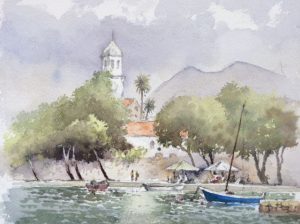Whatever medium you paint with, light is the all-important key. You can bathe your composition entirely in strong sunlight if you wish, but by restricting the brightest parts to one or two localised areas you will achieve more impact.
In this picture I have cut out a  large part of the painting just to illustrate the advantages of the sort of effect you can achieve by concentrating the light into a small part of the composition. The turbulent sea gave sketching on the boat a refreshing spontaneity, although it was not long before it was not just the sea that was starting to turn a bit green……
large part of the painting just to illustrate the advantages of the sort of effect you can achieve by concentrating the light into a small part of the composition. The turbulent sea gave sketching on the boat a refreshing spontaneity, although it was not long before it was not just the sea that was starting to turn a bit green……
Although I finished my book on the Scandinavian Arctic a while ago, I’ve been trying to catch up on so many things, so there’s been little time for blogging, especially with such a tremendous autumn that has tempted me out time after time. David Bellamy’s Arctic Light will be published in May 2017 by Search Press.
With winter with us once more try to get out to sketch those lovely winter trees whenever you can. Choose your days, wrap up well and if you have all your sketching gear ready to hand you can work quickly before you get too cold. I usually take a thermal travel mug with me as the drink will stay warm for ages, and is a great boost to morale when the sun disappears behind a cloud. My book Winter Landscapes in Watercolour is packed with tips on painting winter scenes, working outdoors in cool weather, and making the most of those warm colours, low lighting and evocative winter trees. You can find a copy on my website together with the film of the same name, which has some stunning winter scenery and was produced by APV Films.
On Wednesday 30th the Christmas exhibition begins at Lincoln Joyce Fine Art and the above painting (in full!) will be on display with several others. You will find the gallery at 40 Church Road, Great Bookham, Surrey KT23 3PW Tel. 01372 458481






